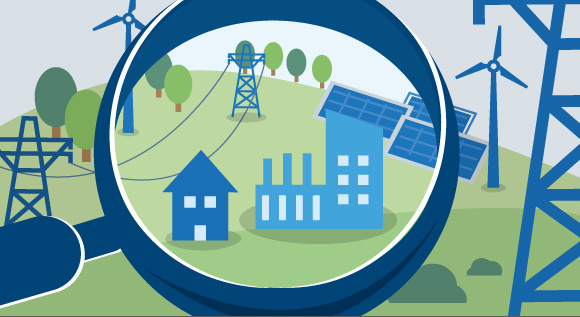What exactly is ecodesign?
From 1 March 2021 new ecodesign rules will apply for a large number of electronic devices including TVs, dishwashers, washing machines, dryers and fridges. Find out here how this benefits consumers and what ecodesign actually is.
 © BMWi
© BMWi
This is what it’s all about: If the question as to how the environmental impact of a product can be reduced is already taken into account at the design stage, this will help mitigate climate change and improve products' energy efficiency.
Are you getting started with your spring cleaning? Then this year, more than ever, the motto is 'repair instead of replace'. From 1 March 2021, ambitious requirements on energy use and new rules regarding repair will apply for TV sets, refrigerators, dishwashers, washing machines and dryers entering the market. Manufacturers will be required to provide access to important spare parts and repair instructions for a period of at least 7 years. The new regulations also stipulate that it needs to be ensured that parts can be replaced 'with the use of commonly available tools and without permanent damage to the appliance'. This means that, going forward, consumers will be able to replace certain parts such as a fridge door seal with tools available in their toolbox. In order to ensure that complex repairs will be carried out smoothly, the new ecodesign regulation picks upon the Federal Government’s proposal to distinguish between spare parts that are made available to end-users and spare parts that are made available to professional repairers. What are the benefits of the new rules? The changes mean that products are not only becoming more energy efficient but can also be more easily repaired and thus used much longer, improving their overall sustainability.
Ecodesign – environmentally friendly standards across a product’s entire lifetime
Ecodesign is about improving a product’s sustainability long before it is placed on the market. By using environmentally friendly solutions already at the design stage, manufacturers can influence the entire product lifetime, for example the product’s manufacturing and the steps leading up to it, its distribution and use all the way to its disposal.
The new ecodesign regulations are technology-neutral: manufacturers can decide for themselves how they fulfil the requirements. In order to meet the new requirements on energy use, designers need to answer a large number of questions whilst still at the drawing board. 'How can the amount of energy and raw materials used in a product be reduced? How can the product’s usability and longevity be improved? How can the product be optimally used?' Durability, ease of repair, adjustability and multi-functionality are important factors to be taken into account in the design of a product. However, every product will fail at some point in time and will then need to be recovered or ideally recycled. This is another aspect that is taken into account in ecodesign. Manufacturers are encouraged to ensure already at the design stage that products or product parts can be reused and, ideally, that the designs are recycling-friendly. The idea is to reduce emissions and make use of materials that are environmentally compatible and not harmful to health. This means that ecodesign adds environmental friendliness to the list of classic product development requirements of functionality, safety and security, ergonomics and value for money.
The Federal Ministry for Economic Affairs and Energy has negotiated the largest package of EU ecodesign measures for Germany thus far
The European Commission’s ecodesign directive of 2005 for the first time established a framework for the setting of minimum ecodesign requirements for energy-related products. These minimum requirements also ensure that inefficient products are no longer placed on the market. The new rules which enter into force in March are the most extensive package of ecodesign measures that has been adopted at European level thus far. To put it together, the European Commission used the ecodesign directive as a basis to develop product-specific regulations together with the industrial sector, consumers, environmental organisations and the Member States. At the heart of the package are minimum requirements for environmentally-compatible product design for certain product groups.
According to the European Commission, reductions under the new rules equal the amount of energy consumed by Denmark in a whole year
In order to make it easier for manufacturers to design products, there are a wide range of checklists, manuals and software solutions that help predict and measure a product’s environmental performance.
Measures to improve energy efficiency can help reduce harmful carbon emissions and make a contribution to speeding up the energy transition. According to the European Commission’s calculations, the new ecodesign regulations will reduce energy use by 167 terawatt hours (TWh) by 2030. This corresponds to the amount of energy consumed by Denmark in a whole year. The new rules not only benefit consumers: high efficiency and longevity standards at European level will also give German manufacturers a competitive edge.

